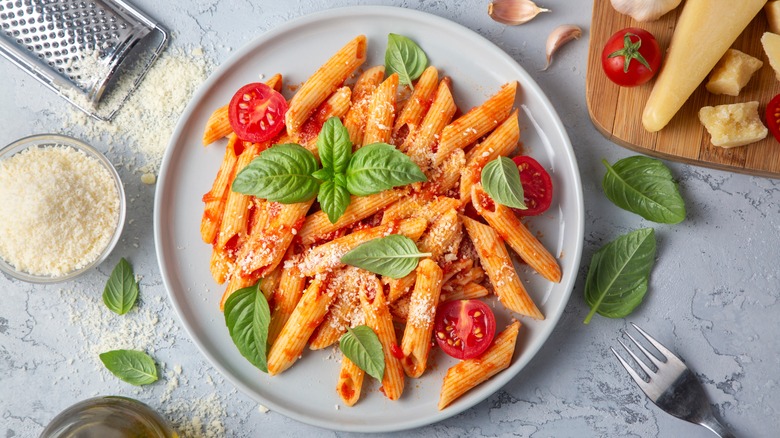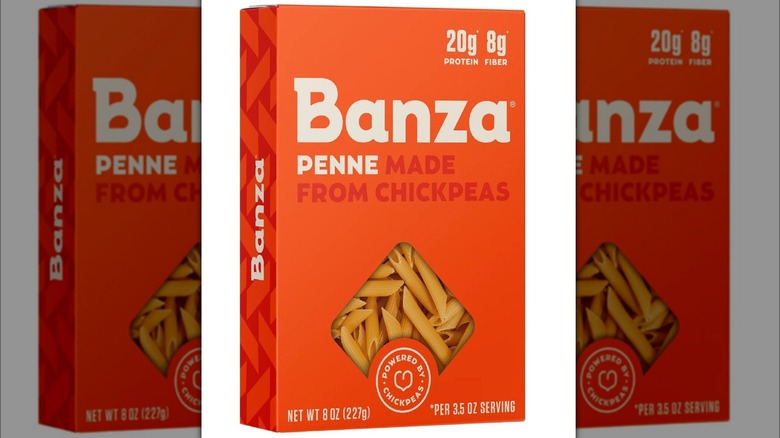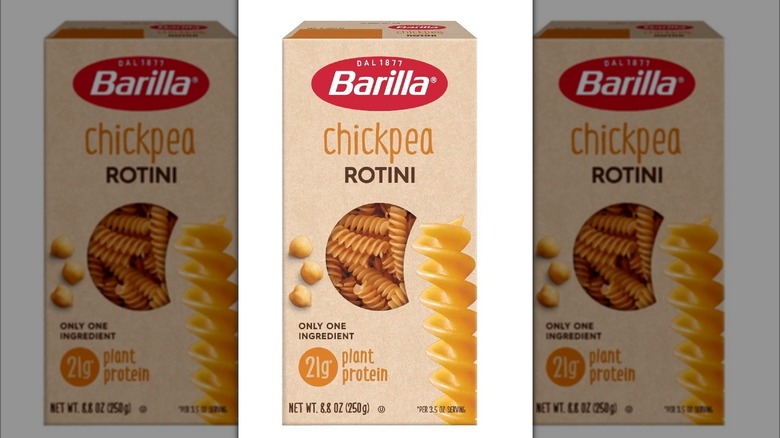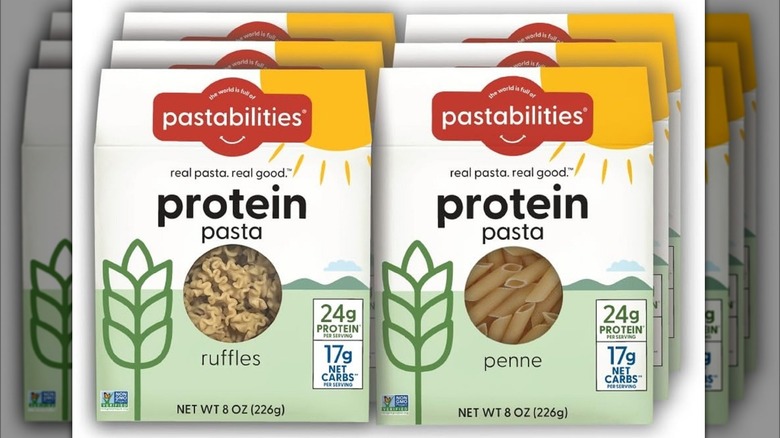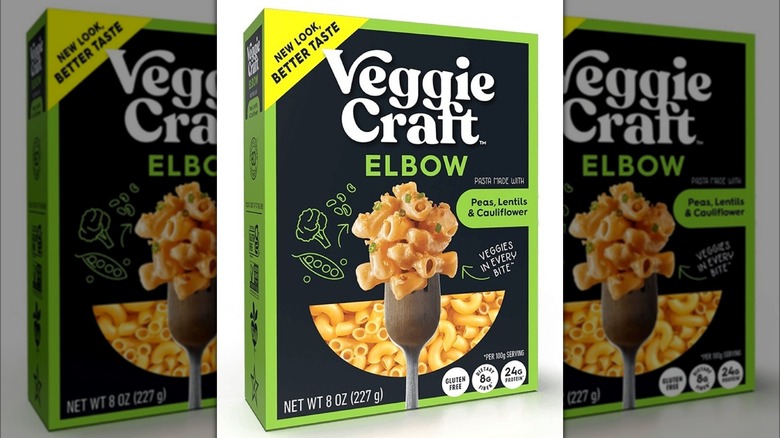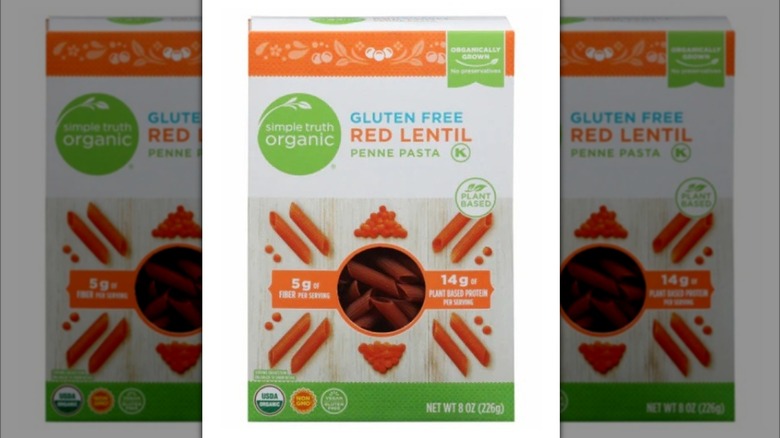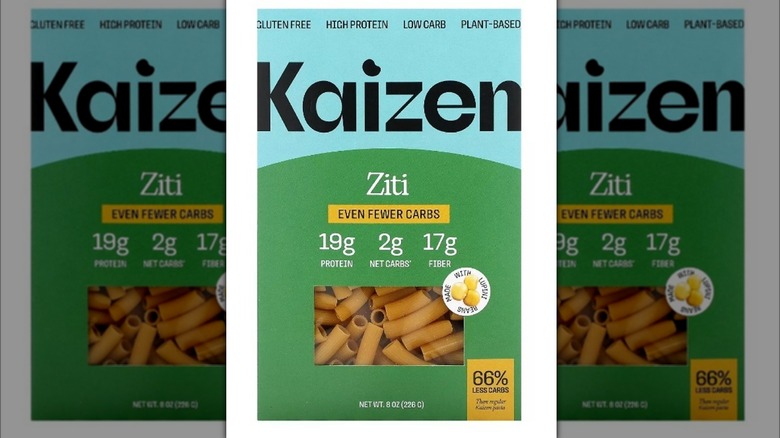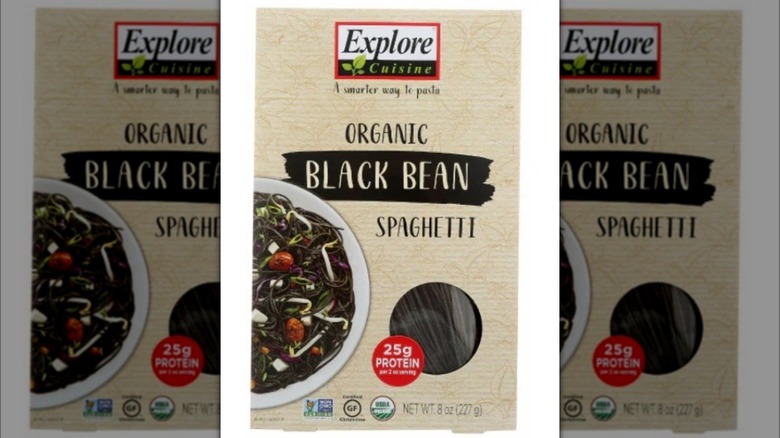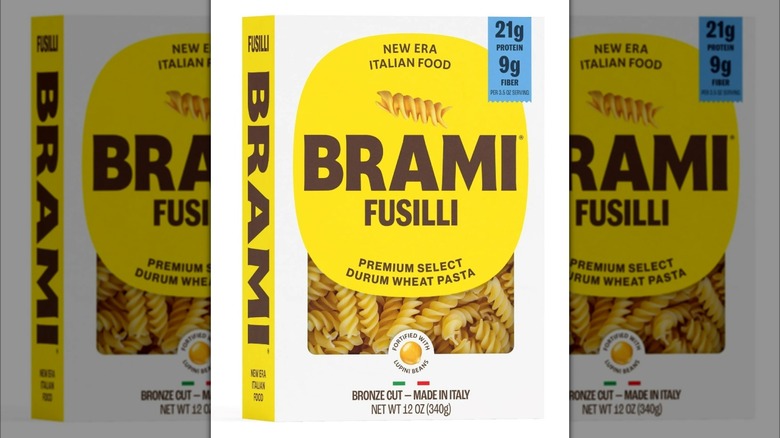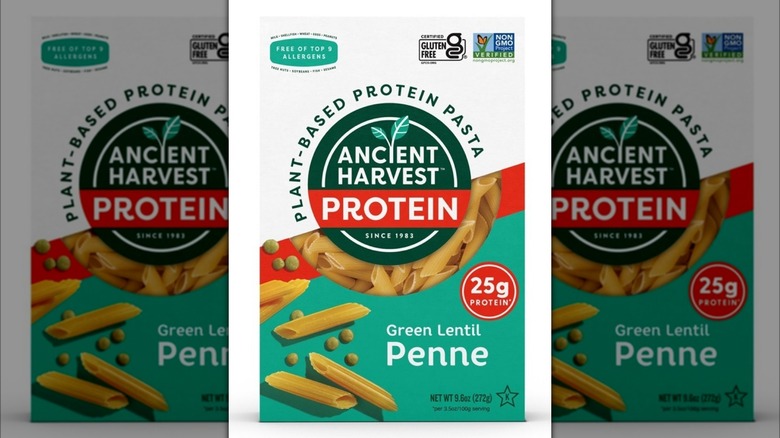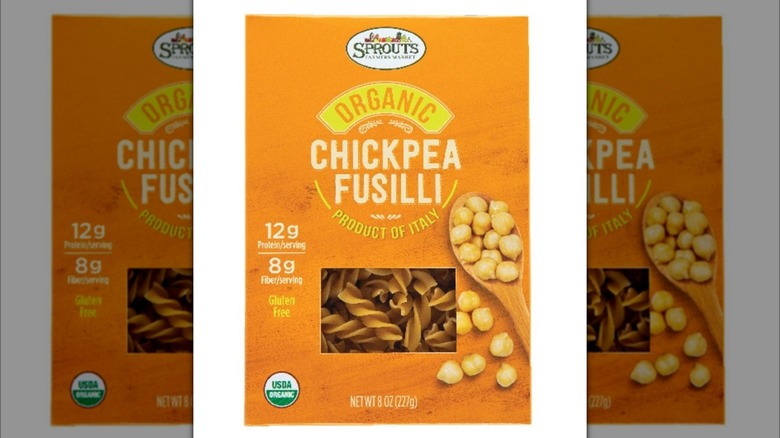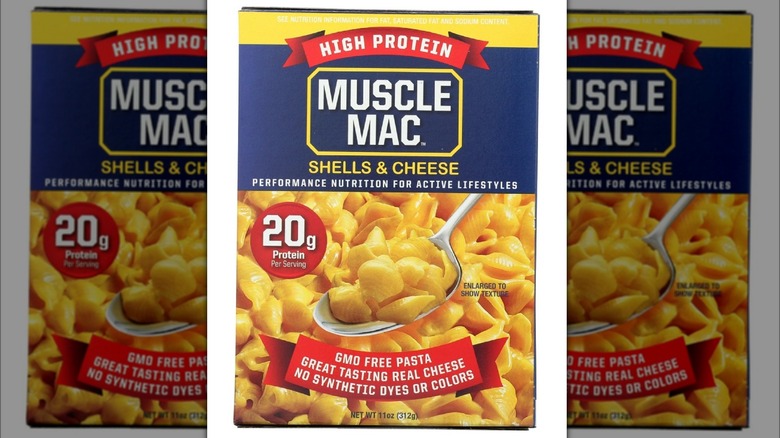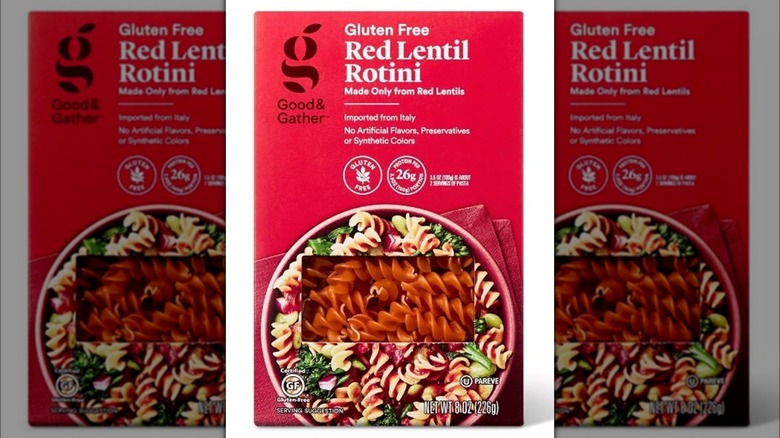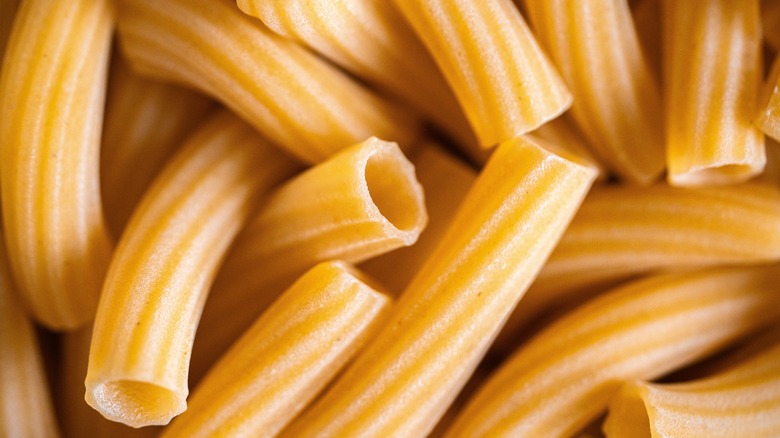12 High-Protein Pasta Brands That Are So Good, You Won't Know They're Healthy
We may receive a commission on purchases made from links.
Aside from bread and potatoes, pasta has always been the most familiar carbohydrate-based food in home kitchens around America. But thanks to innovations in food science and a call for a more protein-packed diet for the modern eater, high protein pastas have muscled their way into the market. Now, pasta fans with their eyes squarely on their macros can enjoy a brimming bowl of their favorite food without losing traction in the weight room.
There are a few ways for food producers to create high protein pasta, using alternatives to wheat flour. Pulses in the gums like lentils and chickpeas can become alternative flowers that ramp up the protein while also eliminating the gluten. We went on an expedition to determine which of these brands offer the best protein rich pasta for your grocery dollars. From familiar brands with new formulas to artisan companies with specialty selections, these boxes are all power players that let you upgrade your pasta game with extra protein in the mix.
Banza
Banza burst onto the scene with a protein-powered pasta made entirely of chickpeas as part of the company's collection of chickpea-centered creations. Apparently, once you understand the capabilities of chickpea flour to bring more protein to the diets of home eaters, you can work it into pre-made favorites like waffles, rice, and pizza, too. The real focus for pasta scavengers, though, are the nifty noodles that perk up plates with a nutritious alternative to the usual boxed product. And nifty these legume-based noodles certainly are; an extensive selection of shapes that includes the usual spaghetti and rotini also features frilled cascatelli, whimsical wheels, and double-twisted gemelli, among others. It's a thorough array of traditional designs that let you adapt your favorite recipes to include additional protein without dropping anything in the bowl but the pasta.
There's more being talked about around the dinner table than just how to get in extra grams of muscle-building protein where Banza is concerned. The company's dedication to using pulses to help add nitrogen back into crop soil while shifting the American diet to a more plant-based model underlies the forward-thinking concept of incorporating chickpeas into more foods as a protein source. This means when you eat Banza, you're not only taking in protein in the shape of your favorite pasta; you're also supporting a sustainable food movement that benefits both the consumer and the planet.
Barilla
Barilla is one of the more familiar names in the pasta aisle, boasting Italian heritage in an easy to prepare product. With a simple tweak of the original recipe, this creative culinary house has given its pasta portfolio a blast of high protein nourishment that's as easy to as the original stuff. The bright yellow boxes that hold these alternative pastas are like a beacon flashing to the fitness-minded eater who can't shake the appetite for Italian dining, letting them know they can have their high-protein diets and enjoy their rotini, too.
To give customers even more options, Barilla takes a two-fold approach to the high-protein pasta proposal. The Protein+ collection uses a blend of semolina wheat, lentil and chickpea flours, as well as pea protein to maximize the content. For eaters with gluten restrictions, the company offers Chickpea and Red Lentil pasta selections that forgo wheat flour entirely in favor of a formula that's solely legume-based. The good news for all three versions is you'll get between 10 and 25 grams of protein depend on the box you choose, all plant-based and all delicious. Depending on the texture you prefer in your cooked pasta, you may need to engage some pasta kitchen hacks to get your Barilla protein pasta to match the traditional stuff, but it's worth the trouble to maintain your dietary goals.
Pastabilities
Pastabilities makes the most of the naming potential for its thoughtful pasta company. The brand goes to extra measures to provide wholesome pasta made with organic ingredients, with high-protein pasta as part of the portfolio. The company also uses natural dyes like spinach, beet, and tomato powders to add color to your most creative noodle assemblage. It's a thoughtful composition of beneficial ingredients that gives the pro-protein crowd additional reasons to celebrate whenever they set the pot to boil.
The shapes of this power pasta are restricted to lighthearted ruffles and buckled-down penne, but that's plenty if your prime objective is enjoying noodles with a protein boost. Regardless of form, Pastabilities makes sure diners get 24 grams of their favorite nutrient by adding chickpea and pea protein to a wheat flour base. Even the pasta selections intended to up your fiber content bring 11 grams of protein into your dinner plans, too. In addition to bare pasta, this boutique food producer also packages its protein pasta as vegan mac and cheese combo boxes, giving health-minded families a nutrient-rich option for their kiddos to dig into.
Veggie Craft
Of all the companies offering protein-loaded pasta, Veggie Craft takes the most inventive approach of all. Instead of simply tossing extra protein into an existing pasta recipe, this producer reduces its ingredients list to a trim trio of elements: lentil and pea flour, plus either zucchini, cauliflower or sweet potato flour for flavor, color, and added nutrients. The result is a plant-based selection that adds new hues to your dinner table while putting good food in your belly and protein in your cells.
Not every shape is available in each flavor combination. Cauliflower offers elbow, penne, rotini, and spaghetti, while zucchini and sweet potato offer penne and spaghetti only. Maybe the most fun aspect of having naturally-colored pastas is that you can toss all three pennes together for a multi-hued pasta salad that brings both color and flavor to your special events without making more work for the cook. Every box also includes 8 grams of fiber and 55 grams net of carbs, balancing the extra protein with helpful elements that strike a winning balance between great flavor and good health.
Simple Truth
Kroger doesn't simply add a protein pasta to its existing line of store-label noodles. It opts for using its organic Simple Truth collection to showcase a pasta that lets red lentils shine in the suppertime spotlight. It's a gluten-free take on the Old World original that uses nothing but organic red lentil flour in the recipe. Though the selection of shapes is limited to penne, this mindful noodle provides a sturdy foundation you can easily adorn with your best sauces and toppers.
Beyond the generous 14 grams of protein packed into every serving, you'll also find a hearty 5 grams of fiber, which is 20% of your whole day's dose. In a single meal, you can knock off two of the most crucial components of your healthy dining requirements. The ruby hue of the pasta itself is enough to dress up a dish sprinkled with fresh veggies (more fiber!), animal- or plant-based meat (more protein!), or your preferred sauce (more flavor!). But even if you top a bowl with a bit of olive oil and a sprinkle of grated cheese, you'll have enough protein to satisfy your hunger for health while slaking your appetite for Italian fare.
Kaizen
Specialty food producer Kaizen promotes its products as pasta and rice variants that contain fewer carbs while serving as gluten-free and high-protein components to make your home menus pop with nutritious and delicious possibilities. These alternative noodles are the perfect base to build vegan pasta recipes around with the easy addition of plant-based dressings, fresh herbs, and chopped veggies. They're also durable enough to take any heavier add-ins you can dish out. And with lower carbs worked into the culinary calculus, home chefs can be a little liberal with those additional toppings while keeping their protein-inclusive recipes from veering into carbohydrate overload territory — a common consideration with traditional pasta. Garlic bread, anyone?
If you purchase directly from the website, you can choose from a slew of shapes that includes familiar fusilli and ziti, plus fun radiatori, which look like coiled springs! No matter what shape you opt for, you'll be getting 20 grams of plant-based protein and 15 grams of fiber in a dish that dials down the carbs to only 6 grams. Kaizen captures the best of all worlds for macro-counters looking to hone in on their daily totals without dumping the possibilities for luxe lunches and delicious dinners down the drain.
Explore Cuisine
Explore Cuisine aims to expand the definition of plant-based, high-protein pasta with its variety of formulas that reach beyond the ingredients used by other brands. You'll definitely find red lentils taking the form of penne and topping every plate with 22 grams of nutrient-dense pasta. With only organic red lentil and organic brown rice flours listed on the back of the box, it's as clean a composition as you're likely to read anywhere in the pasta aisle. It's also a gluten-free option that invites diners with dietary restrictions to join in on the pasta-centered festivities without limiting their plates to just the veggies, sauce, and meatballs. Who doesn't love a pasta that goes out of its way to include everyone in the celebration?
If you're looking to really max out your plant-based protein consumption, Explore Cuisine gives you options with a capital "Oh!" Both the organic edamame spaghetti and edamame and mung bean fettuccine tip the scales at a whopping 42 grams of protein per serving. And the organic black bean spaghetti clobbers you protein count with 45 grams; it also takes on an edgy black shade that makes for intriguing presentations when serving your similarly-minded protein-eating guests.
Brami
Maybe you've heard of lupini beans, one of the base ingredients used by Brami to make pasta with a higher-than-usual protein content. If not, let this company's creations provide an introduction to an alternative legume that brings massive protein to the pasta party. This boutique pasta craft shop creates its noodles using a one-two punch of Italian wheat and lupini beans, though the company calls them Superbeans thanks to the nutritional wallop they pack. True, there may be several pasta rules you should never break, but using an alternative noodle that includes bonus nutrients isn't one of them.
With two-ingredient fusilli, curly mac, radiatori, and penne pastas available in the Brami line, you can replace the star of your prized pasta salads with a more protein-heavy understudy, one that totes along 21 grams of protein and 9 grams of fiber per serving. They'll fit right in at your cookouts and gatherings without calling attention to themselves, letting your fixings and flavorings do all the talking at the table. And if you're intrigued by the Superbeans themselves, Brami also sells a pickled version that would probably be a smashing success as a pasta topper.
Ancient Harvest
Ancient Harvest makes it a mission to introduce distinctive grains into the American diet. This company's extended line offers hot cereals and polenta, but the real draw is the substantial protein quotient of the pasta selections. There's a line of noshable noodles here that let conscious consumers work up to 25 grams of plant-based protein into every serving they devour.
How do ancient grains wheedle their way into an already-tweaked version of a traditional recipe for precious pasta pieces? Why, in the form of quinoa, naturally! This curlicue plant-based powerhouse shows up to the table with an extra protein punch and a suite of nutrients to boot. There are also legumes included in the equation, turning this enterprise's offerings into a rhyming quartet of spaghetti, linguini, elbows, and rotini, each made from a unique mix of quinoa and familiar pulses like lentils and black beans. You can also try Supergrain Pasta, which works amaranth into the blueprint, too.
For a more table-ready dish, Ancient Harvest provides POW! Mac and Cheese, featuring the same lentil-and-quinoa pasta with an organic cheese sauce ready to be whipped up and served hot. It's a protein-forward equivalent of the blue box that crowds other brands off the mac and cheese playing field.
Sprouts
Fresher food outlet Sprouts would be remiss if it didn't introduce a protein pasta of its own to compete with the bigger brands. So, that's just what the retailer did, coming up with its own pair of protein pastas that let shoppers stick with Sprouts-brand items and still deliver nutrient-filled food to their friends and family at dinnertime. Sprouts still shelves other brands of high-protein noodles, but you just know the higher-ups are keeping a close eye on their own contestant in the protein pasta pageant, hoping generous sales of this healthful product will help them pull down a tiara and a sash when they run the numbers.
Sprouts Organic Chickpea Fusilli serves up 12 grams of protein per serving, with 8 grams of fiber riding shotgun. Not one to be outdone by its shelfmate, Sprouts Organic Red Lentil Penne tops that with 15 grams of protein per serving, though the fiber only shows up at 6 grams. Still, it's a nutritional win for pasta lovers looking to curb their wheat intake without upending their taste for creative recipes that toss pasta into the fray. And with healthy competition among the protein pasta set, the real winner in the race for nutritious eating are the customers who know a good thing when they taste it.
Muscle Mac
Muscle Mac makes no bones about taking the potential for protein-dense pasta to the max. Tackling the needs of fitness aficionados and bodybuilders looking for sumptuous meals that add to their diets in the right way, the company reimagined good ol' mac and cheese to compound the proteins in both pasta and dairy for a power bowl that doubles as classic comfort food.
No need to wait until you show signs of needing protein before digging into a bowl. You can gather armfuls of Muscle Mac as a heat-and-eat cup meal containing 20 grams of protein, perfect for a post-workout meal your workout pals tasty enough to make your workout pals jealous. For diehards of the old-fashioned boil-and-toil version, there are boxes of Muscle Mac that will easily slide into the spot in your pantry that Kraft used to occupy. These versions provide the same 20 grams of protein every time you gobble them up. No matter which form you prefer, you can take your pick of traditional, aged sharp white, or white cheddar cheese flavors to add enjoyment to your recovery eating routine.
Good & Gather
Target charges into the market with two protein pasta offerings from its Good & Gather label. There's nothing on the ingredient list of these selections but red or yellow lentil flour, making it easy to know you're getting plant-based protein in pasta form with no weird, wishy-washy additives to make it all stick together. To keep things authentically authentic, Target imports its G&G protein pasta from Italy and eschews chemical dyes, as well as artificial flavors and preservatives. It's as fresh a kitchen component as you can find under the Target home banner, and it gives protein foragers a flavorful find without forcing a stop at a traditional grocery store.
A serving of either Red Lentil Rotini or Yellow Lentil Penne will net eaters 23 grams of protein, though if you choose to top it with other protein sources like meat or legumes, you'll be getting even more of your most coveted macronutrient. There are also 19 grams of fiber, which equates to 69% of your daily intake. With just a single meal, you could practically knock out all your healthy eating in one fell scoop — er, swoop. Adding your own well-advised ingredients to finish off the dish could put you over the top in the Daily Nutrition Challenge, all thanks to pasta that takes protein consumption in undeniably creative directions.
How we chose our pastas
The general baseline for the protein content of classic wheat-based pasta hovers around 7 grams per serving. Though every brand's recipe varies slightly, all appear to come in under 10 grams. We sought out pastas that had more than 10 grams of protein per serving, from the expanding collection of high-protein pastas finding space on store shelves and kitchen tables by utilizing alternatives to wheat like lentils, chickpeas, and quinoa.
In addition to the surplus of protein in these pastas, most companies going to the trouble of ramping up that nutrient also include organic ingredients with higher fiber and lower carbohydrate content, giving careful eaters even more benefits when they switch boxes. The search led to a variety of boutique brands, specialty food producers, and well-known names that find value in providing pasta fans a more beneficial take on this pantry staple that takes the nutrition expectations of modern eaters into consideration.
